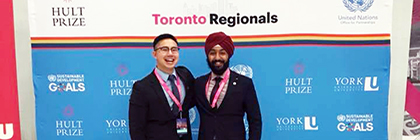Researchers out of York University’s Schulich School of Business have determined that Canada’s market-based form of multiculturalism fosters marketplace inclusion without resource redistribution, and maintains ethnic divides rather than uniting diverse communities.
The findings of this multi-year investigation were published recently in the Journal of Consumer Research and suggest that by celebrating diversity through the marketplace, Canada’s multicultural marketplace turns visible minorities into consumption objects.
“Beyond Acculturation: Multiculturalism and the Institutional Shaping of an Ethnic Consumer Subject” is an in-depth study conducted by Professors Ela Veresiu and Markus Giesler.


According to the researchers, prior consumer research has investigated the consumer behaviour, identity work, and sources of ethnic group conflict among various immigrants and indigenes. However, by continuing to focus on consumers’ lived experiences, researchers lack theoretical clarity on the institutional shaping of these individuals as ethnic consumers, which has important implications for sustaining neocolonial power imbalances between colonized (immigrant-sending) and colonizing (immigrant-receiving) cultures.
Typically, Canada’s multicultural system is not only celebrated as a role model, but heralded also as an example of openness, inclusion and respect of ethnic differences born out of promoting both the growth of the national economy and a multicultural society.
The study includes interviews with a wide range of Canadians, including politicians, market researchers, retailers and regular consumers, as well as institutional-level data, such as Canadian policy documents, market research reports and marketing campaigns.
This type of market-based multiculturalism ends up maintaining ethnic divides rather than uniting diverse communities by turning regular citizens into ethnic consumers, who superficially engage with different ethnicities through their everyday consumption choices, say researchers.
“We bring sociological theories of neoliberal governmentality and multiculturalism to bear on an in-depth analysis of the contemporary Canadian marketplace to reveal our concept of market-mediated multiculturation, which we define as an institutional mechanism for attenuating ethnic group conflicts through which immigrant-receiving cultures fetishize strangers and their strangeness in their commodification of differences, and the existence of inequalities between ethnicities is occluded,” said Veresiu.
The study unpacks four interrelated consumer socialization strategies (envisioning, exemplifying, equipping and embodying) through which institutional actors across different fields (politics, market research, retail and consumption) shape an ethnic consumer subject.
“We conclude with a critical discussion of extant scholarship on consumer acculturation as being complicit in sustaining entrenched colonialist biases,” said Veresiu.
According to the researchers, the study identifies “some of the key institutional actors who, passionately convinced that they are helping build bridges of cultural understanding and cultivating a society of friendly inclusion and ethnic coexistence, produce, circulate and control fetishized differences.”
This leads to further objectifying the stranger and his/her strangeness through the consumption of ethnic brands, products and services in a multicultural marketplace.
This study offers both foreign-born and locally born consumers two critical points for consideration: 1) Just because one’s culture is represented in the marketplace through ethnic brands, products and services, that does not automatically mean that the particular community is included in broader policy and economic decisions; and 2) Citizens should no longer remain complicit in keeping alive all kinds of inequalities by continuing to blindly buy ethnic products without also insisting on fair treatment for all.
In order to uncover fairer immigration policies, world leaders and policy-makers should no longer treat people as consumers. According to the authors, doing so may help us better understand to whose benefit and to whose loss immigration and immigrant experiences are shaped today.















 Student teams from York University include: Jenisha Pudaisini, Marta Michalek and Philip Gingras; and Selina Cozzupoli and Tiana Noce – five of Canada’s brightest marketing minds. They will represent the University and showcase their innovative ideas to prove they are the next generation of marketing leaders. Toronto is no stranger to this competition, and York students have continued to make it into the top 10 year after year.
Student teams from York University include: Jenisha Pudaisini, Marta Michalek and Philip Gingras; and Selina Cozzupoli and Tiana Noce – five of Canada’s brightest marketing minds. They will represent the University and showcase their innovative ideas to prove they are the next generation of marketing leaders. Toronto is no stranger to this competition, and York students have continued to make it into the top 10 year after year.









 Unlike other Master of Science in Marketing programs that are research-focused and lead to PhD studies, Schulich’s one-year Master of Marketing (MMKG) program is uniquely management-focused and designed to prepare non-business and business university graduates to fill progressive marketing positions.
Unlike other Master of Science in Marketing programs that are research-focused and lead to PhD studies, Schulich’s one-year Master of Marketing (MMKG) program is uniquely management-focused and designed to prepare non-business and business university graduates to fill progressive marketing positions.